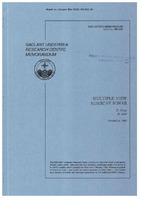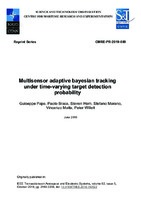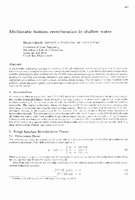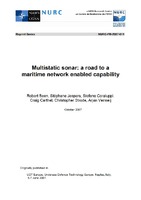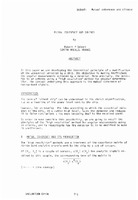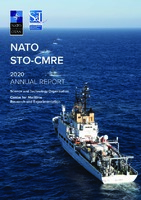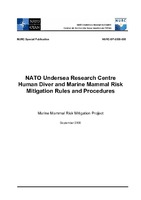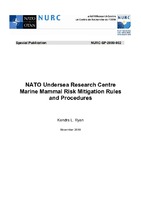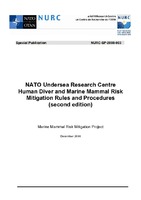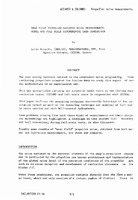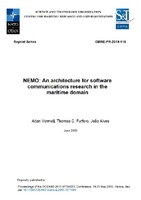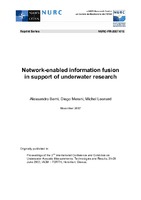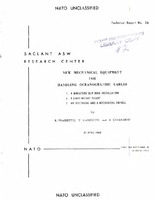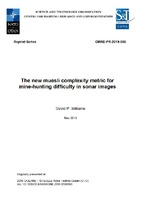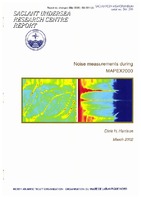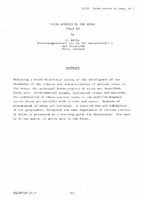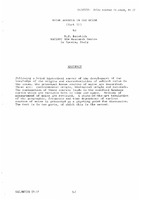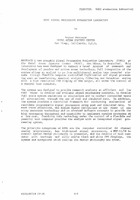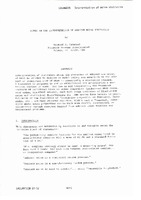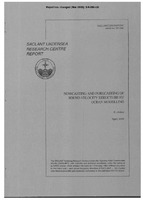Browsing by Title
Now showing items 517-536 of 882
-
Multiple view sidescan sonar
(NATO. SACLANTCEN, 1995/12)The classification of objects on the seafloor by means of a sonar can be -
Multisensor adaptive Bayesian tracking under time-varying target detection probability
(CMRE, 2019/06)In practical tracking applications, the target detection performance may be unknown and also change rapidly in time. This work considers a network of sensors and develops a target-tracking procedure able to adapt and react ... -
Multistatic bottom reverberation in shallow water
(NATO. SACLANTCEN, 1997)A wavenumber integration approach to modeling of the full multistatic reverberant field produced by small-scale bottom roughness in stratified shallow water waveguides has been developed. A perturbation approach to rough ... -
Multistatic sonar: a road to a maritime network enabled capability
(NURC, 2007/10)NATO's operational requirements emphasize interoperability of platforms participating in coalition task forces. Intelligently fusing data of multiple sensor systems and the development of adapted tactics are necessary steps ... -
Mutual coherence and silence
(NATO. SACLANTCEN, 1985/01)In this paper we are developing the theoretical principle of a modification of the acoustical emission by a ship. Its objective is making inefficient the angular measurements achieved by a detector. More precisely, the ... -
NATO STO-CMRE 2020 annual report
(CMRE, 2020-02)This Progress Report describes the Centre’s unclassified technical accomplishments and outputs performed under the 2020 programme of work. -
NATO Undersea Research Centre human diver and marine mammal risk mitigation rules and procedures
(NURC, 2006/09)The NATO Marine Mammal Risk Mitigation project has as its goals the development of risk mitigation protocols, computer tools, and in-water devices to provide risk mitigation before sonar or other noisy experiments and naval ... -
NATO Undersea Research Centre marine mammal risk mitigation rules and procedures
(NURC, 2009/11)The NATO Undersea Research Centre (NURC) Marine Mammal Risk Mitigation Rules and Procedures provides the policy and the procedures to scientific planners, Scientists-in-Charge (SIC), researchers and the Masters of NURC ... -
NATO Undersea Research Centre marine mammal risk mitigation rules and procedures
(NURC, 2008/12)The goals of the NATO Marine Mammal Risk Mitigation include the development of risk mitigation protocols, computer tools, and in-water devices to provide risk mitigation before sonar experiments so to avoid potential ... -
Near field propeller radiated noise measurements: model and full scale experimental data comparison
(NATO. SACLANTCEN, 1985/01)The ever rising interest related to the underwater no1se originating from cavitating propellers prompted the Italian Navy to study this aspect of naval architecture in an experimental way. This was accomplished carrying ... -
NEMO: An architecture for software communications research in the maritime domain
(CMRE, 2019/06)This paper presents a high-level overview of NEMO, an implementation of a communications research software workspace with special focus on application scenarios involving underwater (e.g. acoustic), and other maritime ... -
Network-enabled information fusion in support of underwater research
(NURC, 2007/11)Advanced communication and information processing techniques can be applied to underwater research to enable new ways of enhancing real-time experimental outcome. This paper is concerned with three main areas where ... -
New mechanical equipment for handling oceanographic cables
(NATO. SACLANTCEN, 1964/04)The four pieces of equipment described in this report have been designed to facilitate the handling of oceanographic cables by replacing the heavy, and often expensive, equipment at present in use, with lighter, less ... -
The new muesli complexity metric for mine-hunting difficulty in sonar images
(CMRE, 2019/05)A new image complexity metric has been developed that fuses the concept of lacunarity, a measure of pixel intensity variation, with the notion of spatial information, a quantity that captures edge energy. This new metric, ... -
Noise measurements during MAPEX 2000
(NATO. SACLANTCEN, 2002/03)During MAPEX2000 some simultaneous ambient noise measurements with an HLA and satellite SAR images were collected. The aim was to predict shipping and wind noise from the satellite radar and to compare results with acoustic ... -
Noise sources in the ocean - part 1
(NATO. SACLANTCEN, 1975/10)Following a brief historical survey of the development of our knowledge of the origins and characteristics of ambient noise in the ocean, the principal known sources of noise are described. These are: environmental origin, ... -
Noise sources in the ocean - part 2
(NATO. SACLANTCEN, 1975/10)Following a brief historical survey of the development of our knowledge of the origins and characteristics of ambient noise in the ocean, the principal known sources of noise are described. These are: environmental origin, ... -
NOSC signal processing evaluation laboratory
(NATO. SACLANTCEN, 1979/12)A new acoustic Signal Processing Evaluation Laboratory (SPEL) at the Naval Ocean Systems Center (NOSC), San Diego, is described. This laboratory has been designed to support a broad program of research and development of ... -
Notes on the interpretation of ambient noise statistics
(NATO. SACLANTCEN, 1982/06)Interpretation of statements about the character of ambient sea noise, as well as schemes to measure or model noise, are sensitive to the context or underlying view of what is essentially a stochastic process. A framework ... -
Nowcasting and forecasting of sound velocity structure by ocean modelling
(NATO. SACLANTCEN, 1999/04)The Harvard Ocean Prediction System (HOPS) is applied to an observed oceanographic data set in
